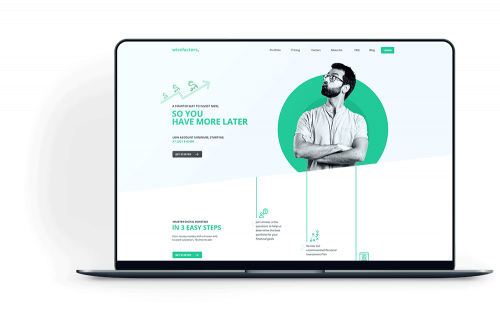Why Constant Branding Issues in Website Design Success
Why Constant Branding Issues in Website Design Success
Blog Article
Maximize Individual Experience With Cutting-edge Website Style Solutions
In today's digital landscape, optimizing customer experience via innovative website design solutions is important for businesses seeking to engage their target market effectively. The combination of interactive aspects can better elevate the user journey, motivating a reevaluation of standard style approaches.
Understanding User-Centric Design

To execute user-centric layout efficiently, it is vital to perform thorough study, consisting of individual interviews, studies, and use screening. These research study methods provide useful data that informs design choices, guaranteeing that the end product lines up with individual assumptions. Additionally, creating individual identities can help designers understand and picture with the end-users, directing the layout procedure toward more appropriate remedies.
In addition, repetitive layout is an essential part of user-centric techniques. By constantly screening and refining designs based upon user responses, developers can identify discomfort factors and areas of improvement, causing a more polished end product. Eventually, user-centric layout is not simply a stage in the development process yet a continuous dedication to focusing on individual needs, leading to more engaging and reliable digital experiences.
Relevance of Responsive Layouts
As electronic communications increasingly occur throughout a range of devices, the relevance of receptive layouts can not be overstated. A responsive design ensures that a website adjusts seamlessly to various display dimensions, from desktop computer monitors to smart devices. This flexibility is essential in today's multi-device landscape, where users anticipate a appealing and constant experience no matter exactly how they access web content.
The main advantage of responsive style is boosted user complete satisfaction. When a site is optimized for all gadgets, it decreases the demand for zooming, scrolling, or straight navigation, which can lead and frustrate customers to higher bounce rates. Additionally, online search engine like Google prioritize mobile-friendly websites in their ranking algorithms, making responsive layouts vital for effective search engine optimization methods.
Additionally, receptive layouts promote easier upkeep and updates. As opposed to taking care of different versions of a site for different tools, a solitary, fluid design can be customized, conserving time and resources. This alternative strategy not just improves efficiency however additionally fosters brand name coherence across platforms. Eventually, buying receptive formats is not just a fad; it is an essential concept of modern-day website design that substantially improves user experience and involvement.
Enhancing Navigating and Accessibility
Efficient navigating and accessibility are crucial components of a well-designed site, substantially influencing customer engagement and complete satisfaction. An user-friendly navigation framework permits site visitors to locate info swiftly and intuitively, lowering frustration and enhancing the probability of repeat sees. Executing clear, detailed tags for navigating web links, along with a logical power structure, can guide users seamlessly through the website.
Availability is equally essential, guaranteeing that all customers, no matter their handicaps or capabilities, can connect with the website properly. This can be achieved with making use of suitable color contrasts, message sizes, and alt message for photos, which together improve the experience for aesthetically impaired customers. Integrating key-board navigation and display reader compatibility expands access for individuals with varied needs.
Routine functionality screening can offer important insights right into navigating performance and accessibility problems. By gathering feedback from genuine individuals, go designers can recognize discomfort points and make enlightened adjustments. Eventually, focusing on navigation and ease of access not just cultivates inclusivity yet additionally cultivates a positive individual experience, enhancing the brand name's dedication to quality and customer treatment in a progressively digital landscape.
Making Use Of Aesthetic Hierarchy Successfully
Visual power structure works as a leading framework in internet site layout, guiding users' focus to the most crucial aspects on a page. By strategically arranging aesthetic elements such as spacing, shade, and typography, designers can produce a clear pathway for customers to adhere to. This structure not just boosts individual experience but also improves material comprehension.
One reliable means to establish aesthetic pecking order is through using dimension and scale. Bigger aspects naturally attract even more focus, making headlines and crucial visuals prominent. Enhancing this approach with contrasting colors can additionally distinguish primary content from second details, making certain that crucial info stands out.
Additionally, the setup of components plays a vital duty in leading user interaction. Using a grid layout can create a cohesive circulation, while whitespace aids to different material and decrease cognitive load - Website Design. This deliberate spacing permits customers to refine details extra easily, leading to boosted interaction
Last but not least, making use of constant style patterns assists reinforce visual hierarchy, offering customers with familiar hints as they navigate the website. By prioritizing these principles, designers can efficiently maximize customer experience, making certain that site visitors can easily situate the details they seek.
Integrating Interactive Aspects
The incorporation of interactive elements right into site style can significantly improve user involvement and general experience. Interactive attributes such as surveys, tests, and sliders not only mesmerize customers yet also advertise active participation, making the surfing experience extra memorable. By motivating customers to communicate, internet sites can properly preserve attention and minimize bounce prices.
Furthermore, incorporating dynamic content like animations and float results includes an enticing layer of interactivity. These aspects can guide individuals without effort with the website, highlighting crucial details and calls to action. Animated switches can attract attention and improve click-through rates.
In addition, this link personalization via interactive devices such as chatbots or referral engines allows web sites to cater to private choices, cultivating a sense of connection. This customized method not just enhances customer contentment yet likewise motivates repeat brows through.
Incorporating analytics devices to track interactions offers important understandings into individual habits, enabling continual enhancement of the interactive aspects. Eventually, a well-designed interactive experience changes a passive browsing session right into an engaging journey, bring about boosted user contentment and commitment. Incorporating interactive aspects is crucial for taking full advantage of user experience in modern-day web site layout.
Final Thought

In today's digital landscape, optimizing individual experience with cutting-edge web site design services is essential for services seeking to involve their audience effectively. Eventually, prioritizing navigation and ease of access not just promotes inclusivity however also grows a positive user experience, enhancing the brand name's dedication to high quality and customer care in a progressively electronic landscape.

In verdict, optimizing user experience via cutting-edge web site style options necessitates a dedication to user-centric principles. Website Design.
Report this page